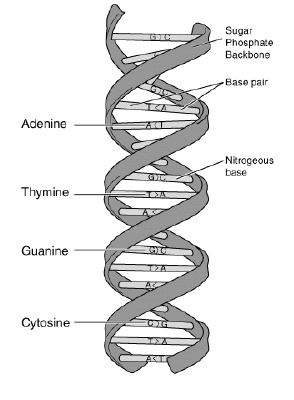LA 3602 UVA 1368 - DNA Consensus String
来源:互联网 发布:林赛氏指甲鉴别 知乎 编辑:程序博客网 时间:2024/04/29 05:46
LA 3602 UVA 1368 - DNA Consensus String
 Figure 1. DNA (Deoxyribonucleic Acid) is the molecule which contains the genetic instructions. It consists of four different nucleotides, namely Adenine, Thymine, Guanine, and Cytosine as shown in Figure 1. If we represent a nucleotide by its initial character, a DNA strand can be regarded as a long string (sequence of characters) consisting of the four characters A, T, G, and C. For example, assume we are given some part of a DNA strand which is composed of the following sequence of nucleotides:
Figure 1. DNA (Deoxyribonucleic Acid) is the molecule which contains the genetic instructions. It consists of four different nucleotides, namely Adenine, Thymine, Guanine, and Cytosine as shown in Figure 1. If we represent a nucleotide by its initial character, a DNA strand can be regarded as a long string (sequence of characters) consisting of the four characters A, T, G, and C. For example, assume we are given some part of a DNA strand which is composed of the following sequence of nucleotides:
``Thymine-Adenine-Adenine-Cytosine-Thymine-Guanine-Cytosine-Cytosine-Guanine-Adenine-Thymine"
Then we can represent the above DNA strand with the string ``TAACTGCCGAT." The biologist Prof. Ahn found that a gene X commonly exists in the DNA strands of five different kinds of animals, namely dogs, cats, horses, cows, and monkeys. He also discovered that the DNA sequences of the gene X from each animal were very alike. See Figure 2.
Prof. Ahn thought that humans might also have the gene X and decided to search for the DNA sequence of X in human DNA. However, before searching, he should define a representative DNA sequence of gene X because its sequences are not exactly the same in the DNA of the five animals. He decided to use the Hamming distance to define the representative sequence. The Hamming distance is the number of different characters at each position from two strings of equal length. For example, assume we are given the two strings ``AGCAT" and ``GGAAT." The Hamming distance of these two strings is 2 because the 1st and the 3rd characters of the two strings are different. Using the Hamming distance, we can define a representative string for a set of multiple strings of equal length. Given a set of strings S = s1,...,sm of lengthn, the consensus error between a stringy of lengthn and the setS is the sum of the Hamming distances betweeny and each si inS. If the consensus error between y andS is the minimum among all possible stringsy of length n,y is called a consensus string of S. For example, given the three strings ``AGCAT" ``AGACT" and ``GGAAT" the consensus string of the given strings is ``AGAAT" because the sum of the Hamming distances between ``AGAAT" and the three strings is 3 which is minimal. (In this case, the consensus string is unique, but in general, there can be more than one consensus string.) We use the consensus string as a representative of the DNA sequence. For the example of Figure 2 above, a consensus string of gene X is ``GCAAATGGCTGTGCA" and the consensus error is 7.
Input
Your program is to read from standard input. The input consists of T test cases. The number of test cases T is given in the first line of the input. Each test case starts with a line containing two integersm andn which are separated by a single space. The integerm(4![]() m
m![]() 50) represents the number of DNA sequences and n (4
50) represents the number of DNA sequences and n (4![]() n
n![]() 1000) represents the length of the DNA sequences, respectively. In each of the next m lines, each DNA sequence is given.
1000) represents the length of the DNA sequences, respectively. In each of the next m lines, each DNA sequence is given.
Output
Your program is to write to standard output. Print the consensus string in the first line of each case and the consensus error in the second line of each case. If there exists more than one consensus string, print the lexicographically smallest consensus string. The following shows sample input and output for three test cases.
Sample Input
3 5 8 TATGATAC TAAGCTAC AAAGATCC TGAGATAC TAAGATGT 4 10 ACGTACGTAC CCGTACGTAG GCGTACGTAT TCGTACGTAA 6 10 ATGTTACCAT AAGTTACGAT AACAAAGCAA AAGTTACCTT AAGTTACCAA TACTTACCAA
Sample Output
TAAGATAC 7 ACGTACGTAA 6 AAGTTACCAA 12题意:给m个长度为n的DNA序列(只有A C G T),求一个DNA序列,使得该学列与所有序列的Hamming距离最小,两个等长序列Hamming距离为字符不同的位置个数。
#include <cstdio>#include <vector>#include <algorithm>#include <cstring>#include <map>#include <queue>#include <set>using namespace std;#ifdef WINtypedef __int64 LL;#define form "%I64d\n"#elsetypedef long long LL;#define form "%lld\n"#endif#define SI(a) scanf("%d", &(a))#define SDI(a, b) scanf("%d%d", &(a), &(b))#define S64I scanf(form, &a)#define SS(a) scanf("%s", (a))#define SC(a) scanf("%c", &(a))#define PI(a) printf("%d\n", a)#define PS(a) puts(a)#define P64I(a) printf(form, a)#define Max(a, b) (a > b ? a : b)#define Min(a, b) (a < b ? a : b)#define MSET(a, b) (memset(a, b, sizeof(a)))#define Mid(L, R) (L + (R - L)/2)#define Abs(a) (a > 0 ? a : -a)#define REP(i, n) for(int i=0; i < (n); i++)#define FOR(i, a, n) for(int i=(a); i <= (n); i++)const int INF = 0x3f3f3f3f;const int maxm = 50+10;const int maxn = 1000+20;char A[maxm][maxn];char anss[maxn];int ans;char mp[4] = {'A', 'C', 'G', 'T'};int cont[4];int id(char c) {REP(i, 4) if(c == mp[i]) return i;}int main() {int T;SI(T);while(T--) {int n, m;SDI(m, n);REP(i, m) SS(A[i]);ans = 0;REP(i, n) {MSET(cont, 0);REP(j, m) {cont[id(A[j][i])]++;}int tmax=0, tmaxid;REP(k, 4) if(cont[k] > tmax) {tmax = cont[k];tmaxid = k;}anss[i] = mp[tmaxid];int tsum = 0;REP(k, 4) if(k != tmaxid) tsum += cont[k];ans += tsum;}anss[n] = '\0';PS(anss);PI(ans);}return 0;}- LA 3602 UVA 1368 - DNA Consensus String
- LA - 3602 - DNA Consensus String
- la 3602 DNA Consensus String
- LA 3602 DNA Consensus String .
- UVA 1368 - DNA Consensus String
- uva 1368 DNA Consensus String
- Uva-1368-DNA Consensus String
- UVa 1368 DNA Consensus String
- UVA 1368 DNA Consensus String
- UVA 1368 DNA Consensus String
- UVa:1368 DNA Consensus String
- uva 1368 - DNA Consensus String
- UVa 1368 - DNA Consensus String
- UVa 1368 - DNA Consensus String
- UVa 1368 DNA Consensus String
- UVa 1368 - DNA Consensus String
- UVA - 1368 DNA Consensus String
- UVa 1368DNA Consensus String
- VS常用快捷键 VS2010快捷键大全
- Windows(x64)编译FFMPEG-2.0.1
- 仿真OK,烧写到目标板就挂了!
- 利用HTK快速建立一个语音命令识别系统
- poj 3260 The Fewest Coins(背包)
- LA 3602 UVA 1368 - DNA Consensus String
- 安卓面试题《三》
- hdu2203 亲和串
- IrfanView浏览目录崩溃的问题
- java用poi解析excel2003和2007并封装成对象返回
- [LeetCode] Word Search
- [Android 分享]GitHub Android 最火开源项目Top20
- linux 查看内存使用情况
- (Android) Lanuch Mode


